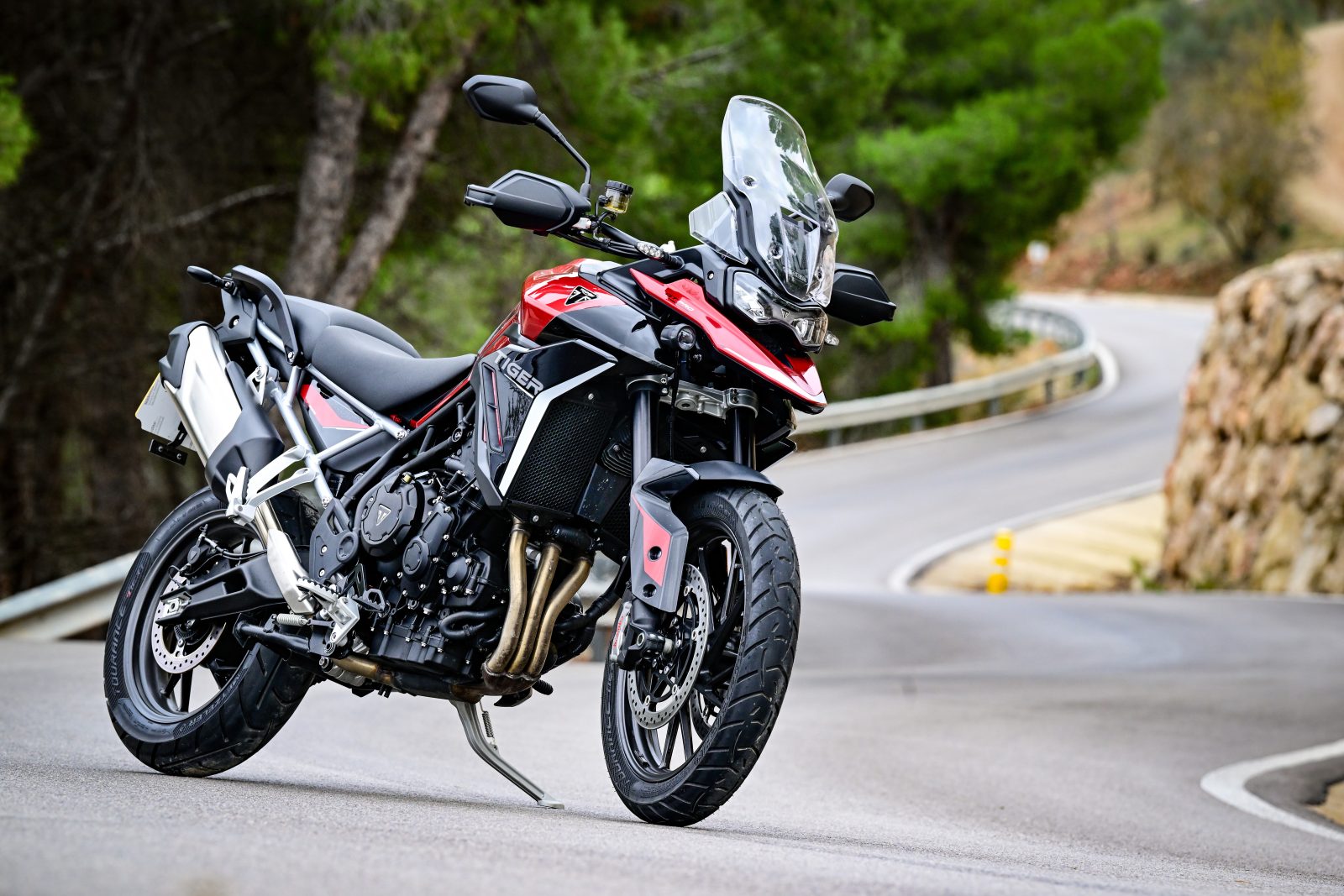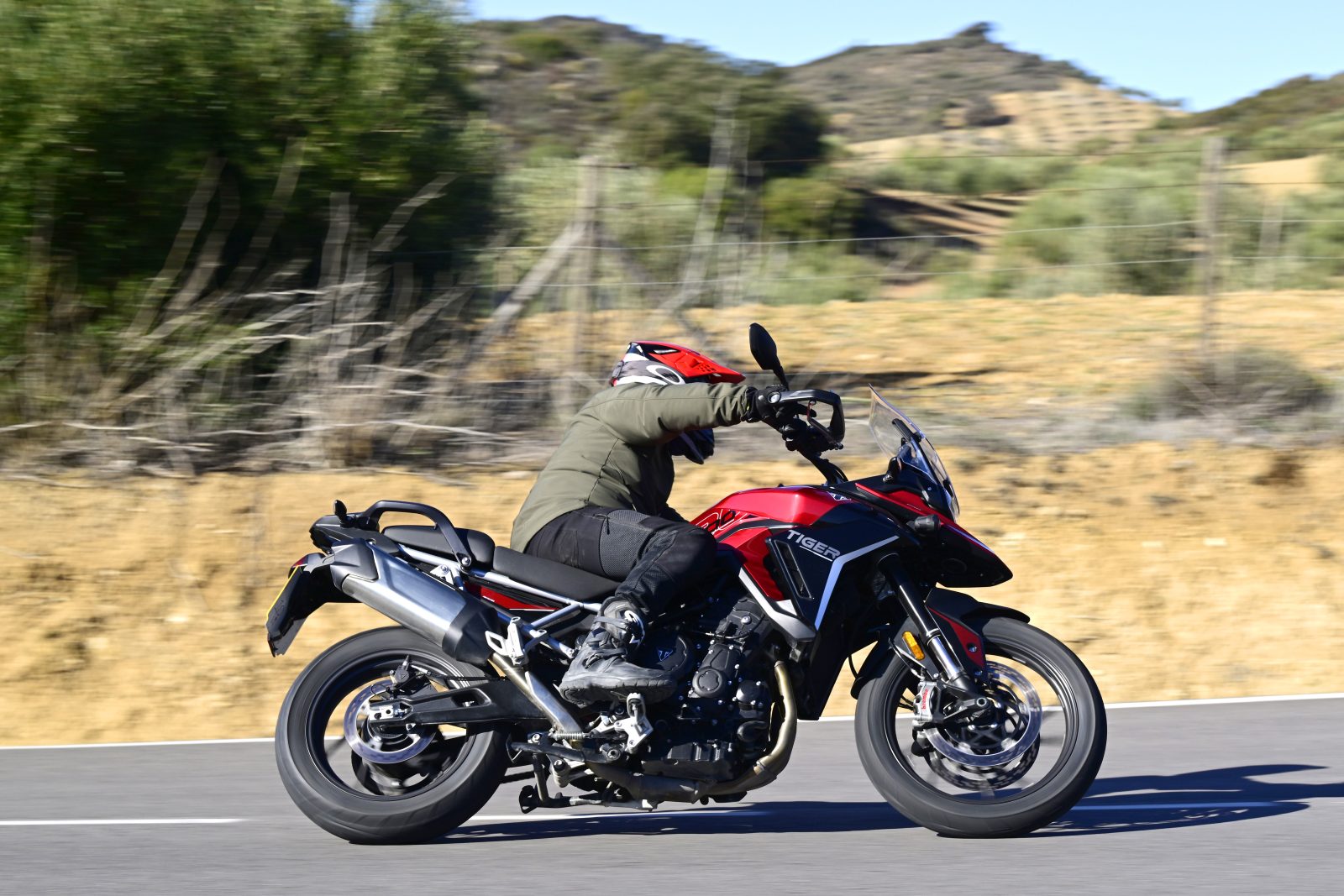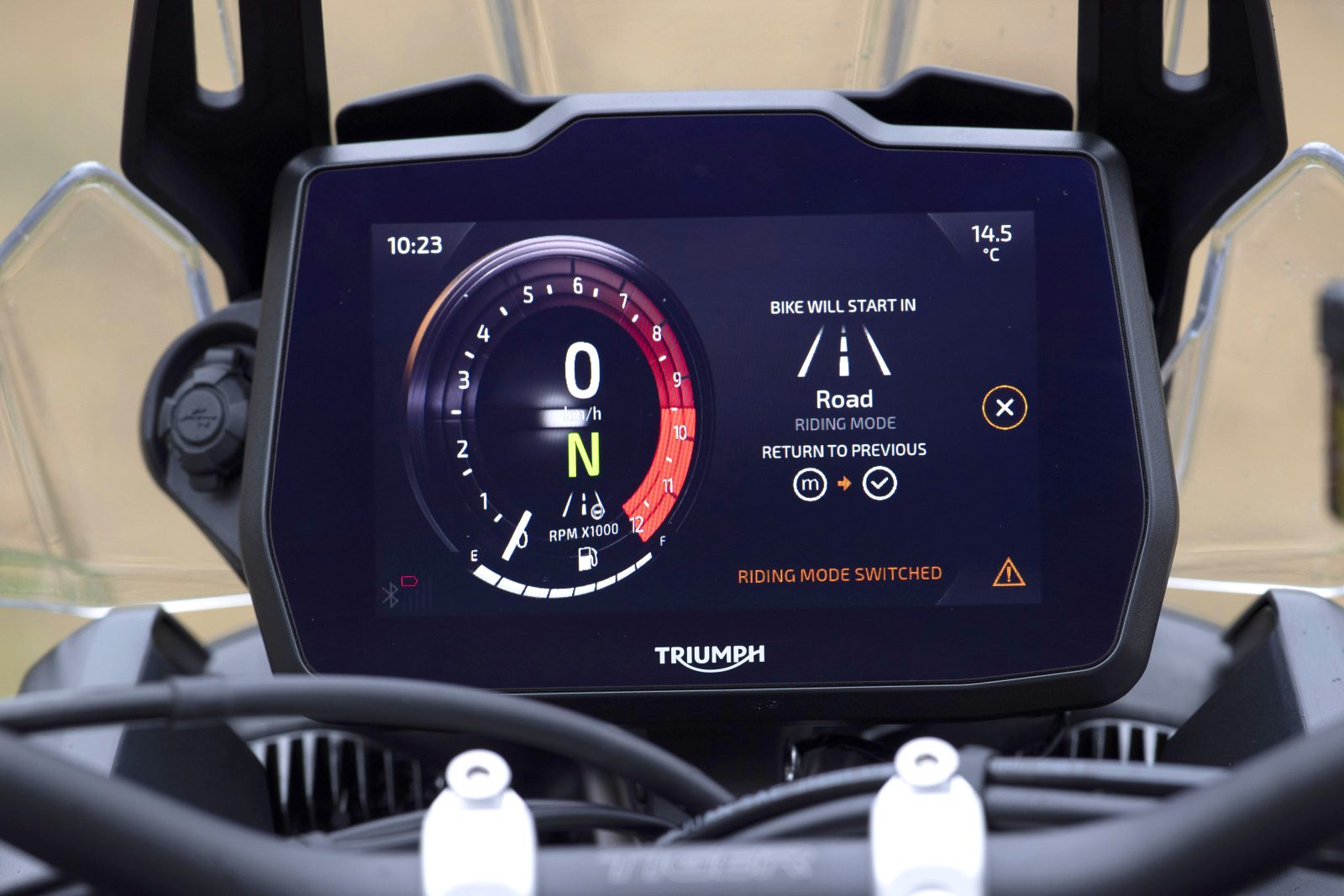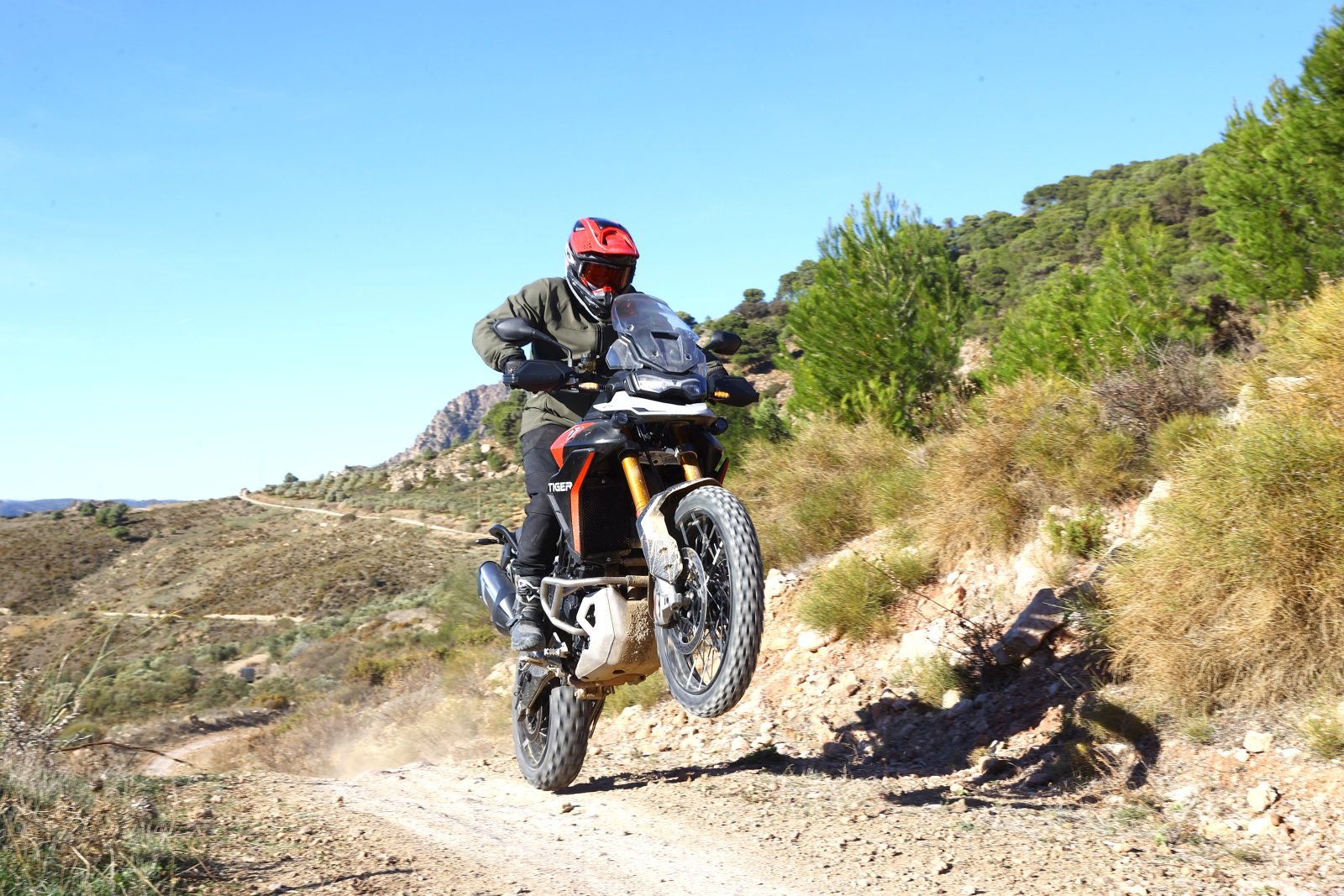The Triumph Tiger 900 range now consists three models: the GT and GT Pro, and the off-road focused Rally Pro. We ride them…
For 2024 the Triumph Tiger 900 range has been streamlined into three models. The Tiger GT comes with a 19-inch front wheel and is available in two variants; the GT and GT Pro, fundamentally a base model and a full-spec version of the same bike. For those seeking more off-road potential, there is the Tiger Rally Pro, with a 21-inch front wheel and more off-road biased suspension, and AMCN sent Desert King Ben Grabham to the Aussie launch of this model recently, and will run full details soon. The Rally is only available as a high-spec Pro version, there is no base model, and all three models benefit from the same performance improvements and share the same peak power and torque.
Peak power has increased for 2024, a jump of 9.5kW (12.7hp) to 79.5kW (106.6hp), along with a 3Nm increase in torque. Triumph has also improved the 900’s tech package, with enhanced rider aids and a new seven-inch TFT display with connectivity which appears on all models.
The 19-inch front wheeled GT and GT Pro models use the same 45mm inverted fork, while the Pro gets a rear shock with electronically controlled spring preload adjustment and the base GT has a conventional manually adjustable shock. Suspension travel is 180mm front and 170mm rear. The Rally Pro, with a 21-inch front wheel, gets conventional Showa suspension front and rear, with 240mm and 230mm of travel.

Triumph’s latest Tiger 900 is much more than just a facelift and a few revised specifications
Unsurprisingly, I felt more comfortable to commit to a fast corner on the lower, more road focused, 19-inch front wheel GT Pro. In comparison, it felt lighter, easier to flow and to enjoy the great roads upon. On paper, it’s only 6kg lighter than the Rally Pro but it feels more, possibly because of that smaller-diameter front wheel and less travel.
It’s no Triumph-powered Moto2 bike, of course, but with less suspension movement and a lighter feel, I could attack roads with confidence and speed. I did scrape the ’pegs from time to time due to the lack of ground clearance compared to the Rally Pro. Some heavier riders on the test did this more frequently. I wasn’t as brave as some, only tickling the ’pegs from time to time, however the conditions were cold and the Metzeler Tourance tyres almost felt overinflated, so I didn’t have the confidence I was expecting.
The Brembo Stylema brakes are carried over from the previous model and, to be frank, didn’t need upgrading given they are race-spec quality. The linked system, which automatically adds a touch of rear brake with each squeeze of the front’s handebar lever, isn’t in any way dramatic, just a small nudge new or inexperienced riders will appreciate. For those who like their rear wheels free of ABS intervention, the standard Off-road mode deactivates the ABS on the rear, leaving just conventional ABS on the front. But on the 19-inched GT Pro, you cannot switch off the ABS completely either.
The dedicated Off-road ABS (which isn’t lean-angle sensitive) works well at stopping a ‘heavy’ bike on a dodgy, untrustworthy surface, especially for inexperienced riders. I was impressed by the system and enjoyed riding the trails with such an excellent safety net. Only those pushing the limits would fault the off-road ABS. Again, there is always the option to turn off the ABS completely on the Rally Pro (see breakout).
The easiest way to increase power and performance is to add cubic capacity, often at the cost of added weight and reduced fuel consumption, but Triumph has kept the Tiger’s capacity at 888cc, meaning no weight penalty but boosted engine performance and improved fuel economy.

The design brief covers a huge range of riding conditions, whether two-up touring or seeking out the best apex on your local backroads weekend blast
Central to the power hike are new pistons and a higher compression ratio, up to 13.0:1 from 12.27:1. There’s an all-new cylinder head, larger intake and exhaust ports, new camshafts and a new exhaust system that delivers an even greater charismatic growl from the T-Plane triple. Peak power now arrives higher up the rev range, at 9500rpm rather than 8750rpm, while torque peaks slightly lower, at 6850rpm instead of 7250rpm. Meanwhile, Triumph reckons the new engine offers a nine percent reduction in fuel consumption, giving a claimed tank range of 425km.
We rode both the GT Pro and Rally Pro on test, and while their overall focus differs somewhat, both machines have the same quoted power and torque and come standard with a quickshifter.
A 9.5kW increase may not sound vast and 3Nm more torque might not overly impress – but you can instantly feel the extra power over the previous Tiger 900, which wasn’t a slouch. Below 5000rpm the Tiger still feels friendly, easy to ride, and very much like the old bike complete with its near-faultless fueling. But from that point upwards you start to notice the difference.
It’s freer revving, there’s more shove, more grunt and more punch. Keep the throttle open and it hits its stride as the revs pass peak torque at 6850rpm. From 7000rpm to the redline it revs manifestly faster and harder than before, with peak power now 750rpm higher than before.
You could debate that adding revs and more top-end power is slightly missing the point on an adventure bike, but there’s nothing wrong with having an extra dollop of horses on top should you need or want it. I, for one, loved carving up mountain roads, dancing on the smooth quickshifter, and watching the clear full-colour TFT digital rev counter bounce between 6000rpm and 10,000rpm.
Not every Tiger rider will want to ride like this, of course, but that increase in zip will make overtakes easier and safer, and for those who ride two-up fully loaded with luggage, it will be especially useful.
In performance terms, the new Tiger is essentially two bikes: a friendly, usable Tiger that’s more of a domesticated moggy below 5000rpm, a Tiger with teeth that commands your attention above 5000rpm, even more so above 7000rpm. It shouldn’t actually bite, of course, because there are a raft of sophisticated new rider aids working in the background if you get a little carried away, but it is a whole lot of fun to ride quickly.

Triumph hasn’t simply boosted capacity to upgrade engine performance of the 888cc triple
The throttle delivery is easier in the dedicated off-road modes, but with the full stable of kilowatts on tap, the new 900 can be playful and lively with the traction control (TC) turned off. The dedicated Off-road traction control works well, smoothly reducing and re-introducing power when it senses the rear wheel spinning faster than the front. Once familiar with it, you can trust and lean on the TC to hold a slide, which is ideal for those less experienced on the dirt. Off-road (with no TC), the Tiger wags its tail like a happy dog. Power slides are flatteringly effortless.
There is also a Rider mode on the Rally Pro and GT Pro, which allows you to create your own custom mode, for either on or off-road. You can even have no TC and just ABS on the front and ride it like a big Supermoto.
Depending on where you ride, you might not easily notice the new Tiger’s improved engine performance off-road, or slow riding on a commute. The upgraded engine is as similarly tractable as the older one at low rpm and to feel the difference you need to be higher up in the rev range on fast open trails, or darting up mountain passes.
A downside is you can’t change riding modes on the move from road to off-road. Having to stop is a bit of pain. You can flick between the road modes with a closed throttle but, for example, can’t flick between road and off-road on the fly. You have to stop, change the mode and get going again.
Triumph has redesigned the seat to offer more comfort, which is now heated as standard on both, along with the pillion perch. There’s also a new rubber-mounted system to reduce the vibrations some Tiger 900 owners have complained of.
The factory has added a flatter, more comfortable seat which they say is 10mm thicker (without increasing seat height). I had two full days in the saddle without any complaints and loved the roomy riding position and the way every control feels natural to operate.

The improved dashboard still has a few niggles
Yes, the screen is manually adjustable via five positions across 50mm of travel, but it’s simple to operate on the move and there’s a distinct difference between the low and upper levels.
I didn’t get a long freeway stint to test comfort at touring speeds but on short blasts the GT Pro was smooth with fewer vibrations, possibly down to the new handlebar damping or possibly because the engine has more power and therefore is working less. Certainly, the new Tiger feels more refined and smoother than before, but we will have to wait for a back-to-back test to confirm by how much.
The dash on the old Tiger was a little controversial (some liked it, others didn’t), and the new full-colour upgrade with connectivity – it’s been lifted from the Tiger 1200 – is certainly a visual improvement.
But while it is smart, clear and simple to navigate, the new dash is also a little slow in operation, with a slight delay when you switch on the ignition and when flicking between modes. Also, the symbol for each mode is small and the display doesn’t differ between modes as it does on some of the competition. It’s a bit of a personal thing but, yes, it’s visually improved, however not in operation. Let’s see if Ben Grabham agrees when we test the Rally Pro with the same dash here in Oz.
Triumph hasn’t made a colossal bounce forward with the new Tiger 900 but has tweaked and evolved its popular adventurer to make it more flexible and fun. The 888cc triple is now a more refined engine. With more top-end power and more midrange grunt it will thrive in a wider range of riding situations. Chassis-wise, both variants are very similar to the previous model, so too are their handling, neither of which should be seen as adverse.
The tech package takes a step up with a new dash, there are improved rider aids and a quickshifter as standard. But the key area of enhancement is performance. That 9.6kW increase in peak power makes it the most powerful bike in this segment (but still down on torque compared to the twin-cylinder competition).
There’s no arguing you get a lot of bike for your money along with a high level of finish and spec. There’s a more refined engine and more comfortable ride – plus cruise control, heated seats and improved fuel economy. And, thankfully, we now only have three models to choose from and not what seemed like a crazy list before.
With KTM’s much-loved 890 and Husqvarna’s uber-cool Norden 901 – not to mention a new BMW F 900 GS and Honda Africa Twin around the corner – it’s a competitive market for the updated Tiger to get on top of. This could be the hardest-fought category of 2024.
Tiger 900 Rally Pro teaser

I MEASURE in at 172cm and I didn’t find the Rally Pro unwieldy or overly tall. It’s relatively narrow and, although I had to plan where I was going to plant my feet, particularly when riding off-road, it wasn’t at all intimidating.
At 228kg, the Rally Pro is by no means light and carries its kilos possibly higher in the chassis compared to some of the competition, but remains manageable for less experienced and short riders, while the turning circle at low speeds is reassuringly tight.
In terms of suspension, there is a clear distinction between the Rally Pro and GT Pro. The Rally Pro has more suspension travel and while the large-diameter 21-inch front wheel slows the steering compared to the GT Pro, the Showa units are controlled, quality items. At my weight and height, I didn’t feel the need to adjust the suspension and the Rally took on everything I could throw at it. Despite its off-road focus, it took on mountain roads with ease and gave good feel in corners despite its Bridgestone’s distant contact patches.
Both maps – Off-Road and Off-Road Pro – have the same peak power and torque but change the rider aids accordingly. There’s ABS on the front only and non-lean sensitive traction control in the standard Off-Road mode (which is also installed on the GT and GT Pro), while in Off-Road Pro there are no active rider aids, not even ABS. Off-Road Pro is only available on the Rally Pro. The Rally Pro was impressive Off-Road, if not a little top-heavy compared to some of the competition. Stay tuned for our full review from Ben Grabham.
WORDS: ADAM CHILD PHOTOS CHIPPY WOOD
SPECIFICATIONS
ENGINE
Capacity 888cc
Type Inline triple, DOHC, four valves per cylinder
Bore & stroke 78mm x 61.9mm
Compression ratio 13.0:1
Cooling Liquid
Fueling EFI
Transmission Six-speed
Clutch Wet, multi-plate, slip & assist
Final drive Chain
PERFORMANCE
Power 79.5kW (106.6hp) @ 9500rpm (claimed)
Torque 90Nm @ 6850rpm (claimed)
Top speed 230km/h (est)
Fuel consumption 5.1L/100km (measured)
ELECTRONICS
Type Not given
Rider aids ABS, traction control
Rider modes Sport, Road, Rain, Off-Road and Rider Configurable
CHASSIS
Frame material Tubular steel
Frame type Trellis
Rake 24.6°
Trail 102.7mm
Wheelbase 1556mm
SUSPENSION
Type Marzocchi
Front: 45mm, USD fork, rebound and compression adjustable, 180mm travel
Rear: Monoshock, preload and rebound adjustable, 170mm travel
GT Pro: Electronically adjustable preload and rebound, 170mm travel wheels & brakes
WHEELS & BRAKES
Wheels Cast aluminium
Front: 19 x 2.5 Rear: 17 x 4.25
Tyres Metzeler Tourance Next
Front: 100/90-19
Rear: 150/70-17
Brakes Brembo
Front: Twin 320mm discs,
four-piston Stylema calipers
Rear: Single 255mm disc,
single-piston caliper
DIMENSIONS
Weight 219kg (90% fuel, claimed); GT Pro 222kg
Seat height 820-840mm
Width 930mm
Height 1460mm
Length 2305mm
Ground clearance Not given
Fuel capacity 20L
SERVICING & WARRANTY
Servicing First: 1000km
Minor: 10,000km
Major: 20,000km
Warranty Two years, unlimited kilometres
BUSINESS END
Price From $21,850 (ride away)
GT Pro: From $24,790 (ride away)
Colour options Snowdonia White, Carnival Red or Graphite Sapphire Black
Contact triumphmotorcycles.com.au